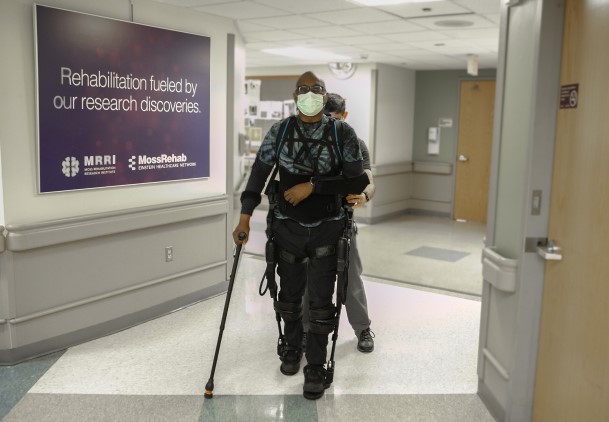
Clinical evidence shows that including EksoNR gait training during rehabilitation improves patient gait speed and walking distance outside of the device at discharge compared to admission.
The adoption of therapeutic robots is on the rise as studies support their benefits to treat neurological disorders for faster and more significant gains. A trailblazer of robotics in neurorehabilitation, MossRehab has the nation’s largest collection of robotic devices, which are used to elevate our standard of care.
A recent addition is a pair of EksoNR Robotic Exoskeletons for training of individuals with walking impairment due to stroke, spinal cord injury, and other diagnoses. By enabling patients to achieve more steps and greater intensity on a repetitive and consistent basis, the exoskeleton device supports higher outcomes.
By including the EksoNR as part of the gait training program, MossRehab aspires to re-train stepping patterns, weight shifting, and posture and get patients back on their feet sooner. According to Andrew Packel, PT, who serves as MossRehab Locomotive Coordinator, “We use the exoskeleton to supplement existing neurorehabilitation programs, especially with patients with more significantly-impaired walking ability who are not able to walk without assistance.”
Manufactured by EksoBionics, EksoNR is a wearable robotic exoskeleton that helps patients with deficits in lower extremity strength and motor control relearn to stand and walk in a rehabilitation setting. The non-tethered exoskeleton augments strength for those who cannot complete conventional gait therapy without assistance. It is the first robotic exoskeleton cleared by the FDA for gait training during neurorehabilitation for persons with a stroke, an acquired brain, or a spinal cord injury.
Helping Patients Take the Next Step
Getting patients back on their feet and walking following an injury to the central nervous system takes intensive and repetitive task-specific training. Traditional therapies often cannot sustain precision stepping consistently. The robotic exoskeleton helps improve stepping as well as increase gait speed and distance that are critical for optimal recovery.
Studies indicate that the therapeutic use of robots – such as the EksoNR – delivers more of the well-defined, repetitive, and functional exercises in a consistent and prescriptive manner. Because of their engagement, therapeutic robotics can reduce discomfort and increase progressively task demand and complexity.
Packel confirms that the best way to help patients improve walking is through practice. Walking practice requires a high dosage of repetition on the order of hundreds to thousands of steps. Without advance technology tools, patients may only take 10, 20, or even 50 steps before they and their therapy team need a break.
“The EksoNR reduces the physical burden of assisting patients while allowing therapists to fine-tune the challenge of the walking task to optimize gains,” notes Packel.
Offering a customizable fit for patients 5’ to 6’4”, the wearable robotic exoskeleton addresses a wide application range to treat a broad spectrum of patients. “Therapists can quickly clean and readjust the EksoNR between patients,” states Packel. “It can take as few as five minutes for patients to get into the device and moving around.”
Software Helps Customize Therapy
Associated SmartAssist software enables the therapy team to customize the use of the device to the specific needs of each individual patient. By monitoring gait symmetry and posture feedback, clinicians can regulate leg movements to minimize compensatory gait patterns and help motivate patients to increase their efforts. In addition to gait training, therapists can use the software to help patients practice balance and sit to stand activities.
“There are different aspects of the walking task associated with lifting a foot and putting it forward such as maintaining stable stance on the other leg, keeping the trunk upright, and, then, maintaining balance throughout walking. The EksoNR allows the therapist to customize the training to help the patient to work on whichever of these different aspects of the walking task that the patient needs to address,” clarifies Packel.
Therapists at MossRehab typically focus on helping patients do more of the walking task themselves to increase their independence and decrease external assistance. “The EksoNR can help patients to walk faster and farther as well as refine and improve their function and activity levels for greater gains,” recaps Packel.
Learn more about MossRehab’s robotic devices.